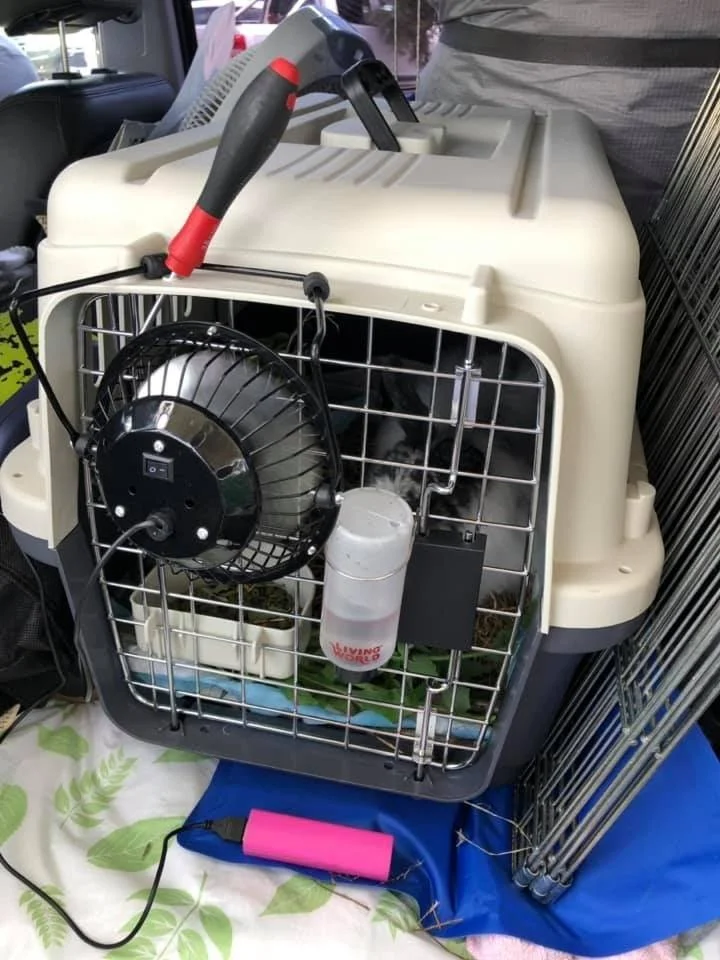Travelling with your Rabbit
Let’s explore some options for you to consider if you need to be away from home for a period of time ... First up ... NEVER leave you rabbit at home alone ... EVER, even just overnight!
Removing your rabbit from their regular home is upsetting for them. Their routine changes and they are away from their home territory and whilst some rabbits cope well with this sort of disruption for others, it is very stressful and can lead to issues such as GI stasis. If you decide not to take your rabbit away with you, here are some alternatives:
* You could leave your rabbit at home with House sitter, full time Pet sitter or have a neighbour look after them by visiting them at your home at least twice a day. You’ll need to make sure to have a ‘training session’ or two with any sitters/minders before you leave so that they are familiar with your rabbit’s routines and will know what to look out for and what to do in case of an emergency.
* You could find another rabbit owner or a friend to board your rabbit with.
* You could investigate whether there are any Vets nearby who have facilities to board rabbits, or if there are any specialised rabbit boarding facilities in your region. You can find a list of boarding facilities in The Bunny Sitters and Groomers section.
If however you do decide or need to have your rabbit travel with you, here are some things to consider:
Preparation before your trip
*Have your rabbit microchipped and fully vaccinated
* Go for some short practice trips to accustom your rabbit to the set up in your car
* Locate a rabbit savvy vet and the nearest after hours vet at your destination so that if there is an emergency you know where to go. Record their contact details somewhere that you can find in an emergency.
The best carrier and setup
If you do decide to travel with your rabbit don’t leave or have them loose in the car. For their own safety, they should travel in a carrier which isn’t too big or too small. Make sure your rabbit can stretch, turn around and lie down. If the carrier is too big and you have to stop suddenly, your rabbit will be thrown around inside the carrier and may be seriously injured. Make sure to strap the carrier into the car so it can’t move around in any way. The best configuration for the carrier is one that is both top and front opening. The top opening will let you attend to your rabbit easily during the journey and the front opening will let your rabbit come and go from the carrier comfortably - especially if you let them out during rest breaks or your use the carrier as their bedroom whilst you are away. Inside the carrier, have a thick pad or similar that will provide a stable surface for your rabbit. This will help them feel secure and safe. You may also want to cover the carrier to further help your rabbit feel secure and to screen out any direct sunlight. Watch out for overheating though if the weather is warm, your rabbit will still need good ventilation.
All About Carriers/Travel Kennels
Best type of carrier for rabbit transport - MediRabbit
How to Set Up a Travel Carrier for Rabbits
Here’s a great idea made by Helen Swiney. The fan is USB powered. There was also a flat chilla pad in the carrier under a puppy pad.
Rest breaks
Travelling is stressful for your rabbit and they will need rest breaks, so make sure to stop at least every 2 hours to give your rabbit a break out of the carrier. During this time offer food especially wetted down greens and lots of fresh, cool water. You can an electrolyte like Vytrate (available from Westley's World) to combat dehydration, but be sure beforehand that your rabbit will drink it. You may have to syringe/dropper feed water. Many rabbits won’t eat during a journey but you can try to entice them with calming and gut soothing herbs such as chamomile, lemon balm, fennel, mint, parsley, a little lavender and coriander as well as tempting foods such as small slices of apple, willow or apple leaves/sticks, plantain, long fibrous grass and Puha, along with any other greens that you know that your rabbit likes, however avoid those which may be gassy etc. Of course, always offer unlimited fresh hay and some pellets as well both during the journey as well as during rest stops.
Reducing stress during the journey
In addition to rest breaks and feeding calming herbs such as chamomile, lemon balm, mint a little lavender etc you could use some some lavender oil in the car by spotting a little onto a cotton ball and placing it out of your rabbit’s reach. Another calming herb is catnip. The best way to use it for your rabbit is cat nip spray - as is sold to encourage play in cats, don’t feed it.
Keeping your rabbit cool
Keeping your rabbit’s body temperate stable during the trip is essential. If the ambient temperature is hot you’ll need to take measures to keep your rabbit cool.
* If your car has AC you can use that to keep the interior cool but make sure your rabbit isn’t directly in the flow of cold air - you could partially cover the carrier to hep with this.
* If you don’t have AC in the car, place wet towels over the cage with the breeze passing through them and provide frozen water cartons to lie against.
* Another tip for travelling with no AC is to put your rabbit’s carrier inside a chilly bin and line the bottom of chilly bin with dry ice. Not only are they cool, it stabilises the cage for travelling and the seat belt can go through the chilly bin handle. DO NOT CLOSE CHILLY BIN LID!
* NEVER leave your rabbit in a parked car EVER. Even in seemingly cool whether or on an overcast day, your car can get dangerously hot inside very quickly.
* Use a crate fan on the door of the carrier. You can buy purpose made crate fans at PetWorkz
How to take your rabbit on a car trip
What to take on the journey
* Chilled water, water bottle and a bowl
* Food - as mentioned above
* Extra bedding/pads/towels etc so your rabbit isn’t in a soiled carrier for too long. You can use puppy pads under some bedding as well to keep your rabbit comfortable bit don’t let them chew them
* Some bags for rubbish
* Wet Wipes for cleaning up messes etc.
* Rehydration solution
* A collapsible play pen
* Waterproof picnic rug to protect the floor at your destination
* An Emergency Kit - including Vytrate, Critical Care/DualCare, syringes and any regular medications your rabbit needs. You can find a check list of items for a Bunnymergency Kit in the Bunnymergency file.
* Your rabbit’s regular bedding
* Tunnels, things to hide in, toys etc
* Your rabbit’s regular litter box and fresh litter
* A soft toy to snuggle if a solo rabbit
* Your rabbit’s harness if they have one
Multiple day journeys
If you need to break your journey overnight then your options are as follows:
* Find a motel ahead of time that will allow you have your rabbit stay in your room with you
* Stay overnight with a friend who has room for your rabbit to be able to be out of the carrier and in a play pen over night.
Upon arrival at your destination
Set up your rabbit’s area as soon as possible with their water, food, litter tray, tunnels etc, leave them to settle in and monitor them without interfering for a while. If they do not start eating, drinking and pooping within a few hours you may need to give them water or Vytrate via a syringe and syringe feed them some Critical Care or mushed up pellets. Keep a close eye on them for signs of stasis and seek emergency help asap if needed.
Copyright 2019 - Jen Herd/Westley’s World
Further Reading
How to Safely Travel with Pet Rabbits - Coops & Cages
Vacations and Travel - House Rabbit society
How to Travel With a Rabbit in a Car - The Spruce Pets



